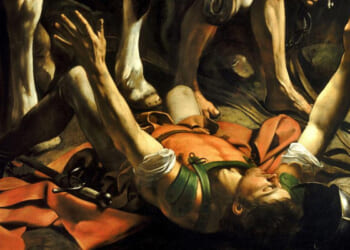Until the Harrier is fully retired by the 2030s, the Trump administration is smart to task these aging but still deadly birds to possibly conduct counter-narcotic operations in Mexico.
Last month, as the Trump administration’s second term was getting underway, a video was posted by the United States Marine Corps’ Naval Air Facility (NAF) El Centro X (formerly Twitter) account. The video lasted two minutes and sixteen seconds, and it displayed a pair of AV-8B Harrier IIs conducting live-fire exercises in the California desert.
The live-fire exercises occurred at the Chocolate Mountain Aerial Gunnery Range in Southern California, around 25 miles from the Mexican border.
Believe it or not, bombing the California desert is nothing new for the Marine Corps. They’ve been doing it for more than 40 years. But, as one X user named Tim Farmer—a Texas-based veteran of the United States Air Force—pointed out, the NAF El Centro X account hadn’t posted a video in five years.
Trump’s Message to the Cartels: We Will Bomb You
It is safe to infer that this exercise was conducted in response to the arrival of Donald Trump as the new Commander-in-Chief. The choice to conduct these bombing exercises so near to the border with Mexico was apparently a signal to the Mexican drug cartels that the U.S. military would take their threat more seriously. Indeed, this was in keeping with the stated policy preferences of the new Trump administration.
Deploying a pair of AV-8B Harriers was an interesting choice, too.
These aging birds have been on the chopping block for some time, as the Marine Corps, like the rest of the Pentagon, seeks to cut funding from its existing programs to pay for the vaunted F-35 Lightning II fifth-generation warplane. Even though the Harriers are older than many of the warplanes in the U.S. military’s air fleet, they are iconic planes in their own right.
The 1994 hit action film, True Lies, starring Arnold Schwarzenegger and directed by legendary Hollywood director James Cameron, features a dazzling sequence in which the action film hero must tussle with a Harrier that has entered hover mode.
Marines Love The Harrier
Indeed, the Harrier’s vertical/short takeoff (V/STOL) has made it a favorite of the unconventional warfighters of the Marine Corps. Since its introduction in the 1960s and its debut as an American warplane in 1971, the Harrier has been a mainstay of Marine Corps aviation.
The current variant used by today’s Marines is the AV-8B Harrier II. This bird can leap from tiny decks or austere fields into combat—making it a darling of Marine Corps aviators, whose mission sets are often more difficult and unique than their naval and Air Force counterparts.
Powered by a single Rolls-Royce Pegasus engine with four rotating nozzles that redirect thrust downward for vertical lift or rearward for flight, the British-designed fighter first caught the wandering eye of the Marine Corps during the Vietnam War, where fixed-wing support often struggled to reach embattled troops shrouded by the thick jungle canopy.
As noted above, the British defense consortium Hawker Siddeley built the first prototype and eventually partnered with the U.S. defense firm McDonnell Douglas to create the AV-8A. In 1976, the Marines took possession of 110 units of the AV-8A. The AV-8B was later introduced in 1985 and eventually upgraded with night-attack and radar variants. These birds today have a 1,200 mile-range and a 9,200-pound payload, with speeds nearing Mach 0.9. Today, around 70 of the planes remain active.
The Harrier Jump Jet: Old But Dangerous
Harriers are armed with a 25mm GAU-12 cannon, plus bombs (such as Joint-Direct Attack Munitions, or JDAMs), rockets, and AGM-65 Maverick missiles. The plane itself is fairly compact. But it packs quite a wallop when it needs to.
During Desert Storm, the Marine Corps’ Harriers flew more than 3,300 sorties from forward bases and smaller Marine Corps aircraft carriers, dropping a whopping six million pounds of ordnance—often closer to troops than any other warplane could manage.
In the post-9/11 wars in Afghanistan and Iraq, the Harrier’s ability to loiter and slowly maneuver over the battlefield to conduct close-air support (CAS) mission sets. The Harriers, like the old A-10 Warthogs, delivered precision strikes within minutes of a call for help from ground forces—saving many American and allied lives in the process.
Many Marines have nicknamed the Harrier “the grunt’s best friend.”
But its service in counterterrorism mission roles, such as the kind that dominated the Afghanistan War and Iraq War, make it uniquely qualified to operate in what many observers believe will be President Trump’s war on Mexico’s vicious drug cartels.
Still, there have been downsides with the Harrier. The complexity of the platform, notably with the nozzles and hover controls, makes it a hog for maintenance. It has higher-than-average accident rates (some reports indicate there have been 140 losses across Harrier variants, often in training). Harrier pilots have complained about the difficulties in getting the bird to balance while hovering. Further, the Harrier is slower and more limited in range than the F-35B Lightning II.
Regardless of the drawbacks, the Marines love this plane. In fact, many Marines think the temperamental nature of these iconic and long-serving warbirds gives the Harrier an edge over other, more advanced systems. And because the Harriers were, until the advent of the F-35B, the only V/STOL show in town, the Marines hung onto this plane far longer than many thought they would have.
Crushing Drug Cartels: A Noble Final Mission?
Just because the Harrier is considered an antique by the other services of the United States Armed Forces, it does not mean that these British-built birds are any less lethal—especially when squaring off against raging drug cartels just across the southwestern border in Mexico. These birds can deliver a wide array of weapons. What’s more, they are highly precise because of their loitering capability. These capabilities were tested during the recent NAF El Centro bombing run in the deserts of Southern California.
Until the Harrier is fully retired by the 2030s, the Trump administration is smart to task these aging but still deadly birds to possibly conduct counter-narcotic operations in Mexico.
About the Author: Brandon J. Weichert
Brandon J. Weichert, a Senior National Security Editor at The National Interest as well as a contributor at Popular Mechanics, who consults regularly with various government institutions and private organizations on geopolitical issues. Weichert’s writings have appeared in multiple publications, including the Washington Times, National Review, The American Spectator, MSN, the Asia Times, and countless others. His books include Winning Space: How America Remains a Superpower, Biohacked: China’s Race to Control Life, and The Shadow War: Iran’s Quest for Supremacy. His newest book, A Disaster of Our Own Making: How the West Lost Ukraine is available for purchase wherever books are sold. He can be followed via Twitter @WeTheBrandon.
Image: Shutterstock / BlueBarronPhoto.

















